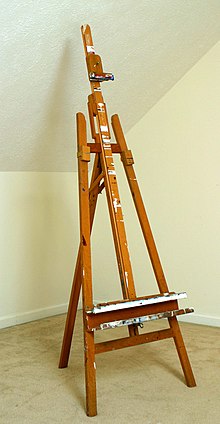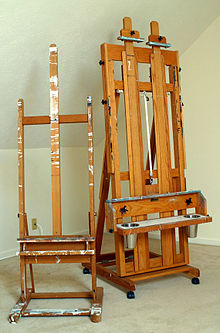Cavalete

Content
Etimologia
A palavra cavalete é um antigo sinônimo germânico para burro (compare semântica semelhante). Em várias outras línguas, seu equivalente é a única palavra para o animal e o aparelho, como africâner: essel e holandês anterior: ezel (o cavalete geralmente em pleno holandês: schildersezel, "burro do pintor"), eles mesmos cognatos do latim : Asinus (ASS).
História
Os cavaletes estão em uso desde a época dos antigos egípcios. No século I, Plínio, o ancião fez referência a um "painel grande" colocado em um cavalete.
Projeto

Existem três projetos comuns para cavalheiros:
A Frame designs are based on three legs. Variations include: crossbars to make the easel more stable; and an independent mechanism to allow for the vertical adjustment of the working plane without sacrificing the stability of the legs of the easel.H-Frame designs are based on right angles. All posts are generally parallel to each other with the base of the easel being rectangular. The main, front portion of the easel consists of two vertical posts with a horizontal crossbar support, giving the design the general shape of an 'H'. A variation uses additions that allow the easel's angle with respect to the ground to be adjusted.Multiple purpose designs incorporate improved tripod and H-frame features with extra multiple adjustment capabilities that include finite rotational, horizontal and vertical adjustment of the working plane.Diferenças
Um cavalete pode ser de altura total, projetada para permanecer sozinha no chão. Os cavaletes mais curtos podem ser projetados para uso em uma mesa.
Artists' easels typically are fully adjustable to accommodate for different angles. Most have built-in anti-skid plates on the feet to prevent sliding. They are collapsible and overall very slim in stature to fit in small spaces around the studio. The simplest form of an artist's easel, a tripod, consists of three vertical posts joined at one end. A pivoting mechanism allows the centre-most post to pivot away from the other two, while the two non-pivoting posts have a horizontal cross member where the canvas is placed. A similar model can hold a blackboard, projection surface, placard, etc.Pochade boxes are a type of artists' easel that is mounted on top of a camera tripod. They include both a support for the painting, as well as a palette. They may or may not include a box for supplies.Paint stations are meant as more stationary consoles. These are usually equipped with various holsters, slots and supporting platforms to accommodate for buckets, brushes and canvas styles. Most of the components can be broken down for easy cleaning and storage.Children's easels are intended to be more durable. They are typically shorter than standard easels and usually come equipped with dry erase boards and/or chalkboards attached.Display easels are for display purposes and are meant to enhance the presentation of a painting.Facilitation easels are for capturing audience or participant input and are meant to involve the participants with the content.Darkroom easels keep photographic paper in a flat or upright (horizontal, big-size enlarging) position to the enlarger.Usar
É mais frequentemente usado para segurar uma tela de um pintor ou um grande caderno de desenho enquanto o artista está trabalhando, ou para manter uma pintura completa para exposição.
Aqui estão alguns usos comuns para cavalheiros:
Studio easels are meant for use in the artist's studio with limited need for the easel to be portable. Studio easels may be simple in design or very complex, including winches, multiple masts and casters. The largest easels are studio easels, with some being able to support panels weighing over 200 pounds and measuring over 7 feet in height.Field easels or plein air easels are meant to be portable for the creation of en plein air work. These easels are usually midsize or small, have telescopic or collapsible legs and are based on the tripod design. French box easels include a compartment in which to store art supplies conveniently along with a handle or straps so that the French box may be carried like a briefcase or a backpack.Display easels are meant for the display of finished artworks. These easels tend to be very simple in design with less concern for the stability needed by a working artist. Display easels vary in size and sturdiness depending upon the weight and size of the object to be placed on them.Facilitation easels hold large pads of paper and have trays for holding markers of varying colorsMini easels are similar in design to display easels but scaled down to accommodate photos or flyersDarkroom easels hold photographic paper perfectly flat during exposure. Some of these easels are designed with adjustable, overlapping, flat steel "blades" to crop the image on the paper to the desired size while keeping an unexposed white border around the image.





